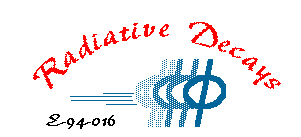

Radphi Video Conference 10/18/02
October 17, 2002
University of Connecticut
Storrs, CT
Present: C. Steffen, R. Jones, M. Kornicer, D. Steiner, S. Teige,
D. Armstrong, D. Krop.
D. Steiner:
S. Teige:
- Scott is waiting for a table of gate widths from RJ and
some 3pi0 mass plots from D. Armstrong.
D. Krop:
- self-consistency check. Takes data and divides into t-bins
and gets average acceptance (from MC). Will send RJ an email
describing his consistency check. He is making experimental moments,
and then will do a fit to the moments.
M. Kornicer:
-
PSFP.
- Hot blocks have now been updated in the map and uploaded to CVS.
- Now he has looked at a double Gaussian (7 parameters) and a
dual Gaussian of cylindrical shape (4 parameters). To fit
each of these parameters as a function of E, Theta would require some
24-40 coefficients.
- Before attempting this study, he decided to look at MC to see if
the shape could be derived from simulation. He found that the results from
1-G fit for radius depends somewhat on exactly where the cluster is
located on the face of a block. When he produced his simulation in the
same region as the selected real data showers, the comparison was very good.
- There is still one poorly-controlled part of the simulation, and
that is the average attenuation length of light in the blocks. D. Armstrong
noted that this is a strong function of radius r. Scott suggested
that the strong variation was confined to the blocks within a radius of
4 block-widths of the hole center. This remains to be studied.
To see this effect, it might be useful to compare low-angle showers in
real data before and after the July 4 shutdown, because the glass blocks
that showed significant radiation damage around the beam hole were
cured during that period.
This page is created by
Mihajlo Kornicer



